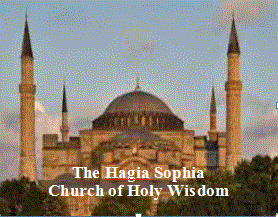Although many may not have been aware of it, but during the period from Easter to Ascension the Shroud, which we removed from the Good Friday Grave on Eastern Sunday morning, traditionally remains on the Holy Table. The Divine Liturgy and services are celebrated on top of the Shroud. Then, on Ascension Thursday, it is taken from the Holy Table and stored away. In some churches it is actually hung in a frame on the wall of the holy of holies.
I relate this particular liturgical detail to illustrate one of the characteristics of our Church. It attempts in so very many different ways to make the experience of the life of Christ real to us and to help us understand that all of the events of His life are, in the eternal dimension, taking place right now. All of these ritualistic actions make our faith more concrete. Our Church wants these events to be more than just abstract memories or purely intellectual ideas. She hopes that in some way they are experiential and real to us.
Another way she also makes our faith more experiential is by asking us, in accord with Sacred Tradition, to STAND IN PRAYER during this time. Standing, while we pray, emphasizes that we are heirs to the Kingdom and, as heirs, we have been granted the privilege and the permission to stand in the presence of God, our Heavenly Father and King. The first time that we will kneel in prayer will be on the feast of Pentecost.
Again this simple liturgical directive is meant to help us experience in some real way that which we say we believe. These are simple actions which are meant to make our religion much more concrete and real.
Now I will admit that not all of our churches include these traditional practices. I believe that is a great loss since I think that these practices really help us to experience our faith. They truly recognize the genius of the Byzantine Eastern Church. The Greek Fathers were truly masterful in finding ways to make the experience of our faith real. Think about it: the faith can be seen in the structure of the worship space, in the actions of the services, in the sights and sounds of the worship and even in the vestments of the clergy. One has to admit that it had to be under the inspiration of the Holy Spirit that the Greek Church created and fashioned our worship. This is one reason why the Slavs, when they went to Constantinople and experienced the worship of God in the Great Church, Hagia Sophia, came back to Rus and exclaimed: During prayer we did not know whether we were in heaven or on earth. Hopefully that is our experience!

